In the world of transportation and heavy hauling, the process of load shift and transfer is a critical aspect that demands the utmost attention. Load shifts can occur during transit, potentially leading to hazardous situations and costly accidents.
In this post, we’ll delve into the challenges posed by load shift and transfer and explore the solutions that professionals, including those offering rotator services and towing, employ to keep cargo secure and roadways safe.
Understanding the Challenge
Load shift and transfer refer to the movement of cargo within a vehicle or trailer during transportation. These shifts can lead to various problems, including:
- Imbalance: A sudden load shift can throw the vehicle off balance, making it difficult to control, especially in adverse weather conditions.
- Cargo Damage: Shifting cargo can damage the goods being transported, leading to financial losses for both the transporter and the client.
- Safety Hazards: Load shifts can pose significant safety hazards for everyone on the road. Loose cargo can fall onto the roadway, creating obstacles for other vehicles and increasing the risk of accidents.
- Legal Issues: Load shifts can result in legal issues if they lead to accidents or damage to public property. These legal troubles can be costly and damaging to a company’s reputation.
The Solutions
Addressing load shift and transfer challenges requires a combination of preventive measures and effective responses when issues arise. Let’s explore some key solutions:
- Proper Loading: The foundation of preventing load shifts is proper loading. This includes distributing the weight evenly and securing the cargo with appropriate restraints.
- Secure Strapping and Tying: Using high-quality straps, ties, and fasteners can help keep cargo in place. Professionals offering rotator services and towing understand the importance of these tools in securing loads.
- Well-Maintained Equipment: Ensuring that the vehicle or trailer used for transportation is in good condition, with well-functioning suspension and braking systems, can help reduce the likelihood of load shifts.
- Driver Training: Proper training for drivers is essential. They need to know how to load and secure cargo effectively and understand the signs of load shifts during transit.
- Monitoring Systems: Employing advanced monitoring systems can alert drivers to load shifts as they occur. These systems can provide real-time data on load stability.
- Emergency Response Plans: Being prepared for load shifts is crucial. This includes having a plan in place for responding to load shifts during transit, such as contacting a rotator service or towing service if needed.
- Professional Assistance: In cases where a load shift does occur, professional rotator services and towing companies play a vital role. They have the equipment and expertise to safely handle load shifts and restore stability.
The Role of Rotator Services and Towing
Rotator services and towing providers are well-versed in addressing load shift and transfer challenges. They offer specialized equipment, such as rotator trucks, capable of handling complex recovery situations. When a load shift happens, calling on these professionals can make a significant difference in mitigating the issue and preventing further damage or accidents.
Sum Up
Load shift and transfer challenges are an inherent part of the transportation industry. The key to addressing these challenges lies in prevention through proper loading, securing cargo, maintaining vehicles, and providing driver training. When issues do arise, professional assistance from rotator services and towing companies can be the solution to ensuring the safety of cargo, the roadways, and all those on the journey. Load shift and transfer challenges are an ongoing concern, but with the right measures in place, they can be managed effectively.



